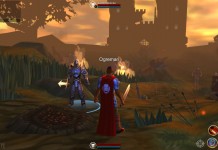The browser-game market is a good place for casual gaming, and it’s also an excellent place for hybrids of the real-time-strategy genre of games. As a historical-fantasy themed RTS, Forge of Empires falls well into this casual niche—in fact, from my experience, it seems to forcefully press people into the casual nature of the game. Also, I use the term “historical-fantasy” because this game doesn’t appear to have any magic involved beyond a sort of Civilizations technology tree that moves from the Bronze Age through the Mediaeval and towards the late Middle Ages.
This game is deliciously casual. In fact, all of the buildings can take minutes-to-hours to develop all of their various resources. This is just like other browser-based games; however FoE gets there a lot more quickly than any of those games. It does a good job in the initial questing to deliver the experience of building the town and taking over a neighboring region, immediately thereafter players find themselves ready to wait an entire day to come back to get more done.
Forge of Empires is published by InnoGames and just entered into a VIP closed beta. As a game, it’s not complete yet so we’re looking at what will be potentially—although the cash shop is currently available and taking money so it seems like it’s probably as close as it’ll get before they go open.
This is a game for very casual RTS players; unless they’re willing to spend money to become beasts in this game.
Gameplay: An RTS game through-and-through that enforces the concept of casual
In its aspects similar to Civilization or perhaps even Sim Early Humanity I was given a village, with a city hall, and a bunch of plots of land, and some roads. From there, I had access to some low tech level houses and a population. The game directed me very quickly to start off my town, raise a military, and begin to produce resources like a proper RTS game.
The RTS building component is extremely easy to access and the tutorial makes it obvious how to proceed. So there’s no problems here. In fact, it’s very staid and extremely easy to get into. Buildings are accessed as the player continues to play and research points are allotted. Another thing that’s neat about this game is that as research and conquering continues, it opens up more slots in opening up more area to plant buildings.
Like every other RTS game, I started out building huts that give me money (every so many minutes) and up my population. Next I have to make sure the population is happy by building cultural buildings, or areas, such as obelisks, gardens, and trees. Next I get to make production-buildings that make a resource called utilities (or various different items that I have quests to make). The quests deliver more resources in of themselves such as gold or utilities.
Finally, I can make buildings that make my military—right now they’re just spearmen who run up and stab people.
Attacking other regions is a significant portion of the game and that delivers both money and utilities, but it can also give immediate access to new buildings. First I was asked to scout out a nearby region (presumably lorded over by another king) and then I was asked to kick his teeth in. Of course, for the cost of a few diamonds (100 or 200) I could have negotiated for the region. I suspect that allows me to skip combat—this could make the game go much faster.
Combat is on a hex-grid where the units are moved across the field in turns. When they’re in attack-range they take turns hitting one another until someone dies. I assume units have certain settings for health, damage, number of attacks, and range of movement—some units attack at range. On the map, certain types of terrain confer particular defense benefits (or perhaps also slow movement through them.) In the beginning, simply having a lot of units will overwhelm the enemy faster than better units.
For those who don’t like micromanaging combat for advantage can click a button and have it fought automatically.
Interesting fact: other players can attack you while you’re offline! Another interesting fact: so far, most of them lose to my beginning forces… I doubt that this will continue to be the fact as they build themselves up and conquer regions and bulk up their militaries. Of course, if I kept coming back for 10-20 minutes a day to make sure I collected all my resources, picked up research, and enhanced my military I’d probably stay ahead of the curve of my attackers.
I am not sure if I get anything out of when people attack me and lose.
Perhaps just an ego boost when I log in.
Graphics and Sound: Browser-based RTS game with a 2D interface, pretty basic here
The graphics for Forge of Empires are fairly basic, but they’re a semi-photorealistic rendering of various buildings with a scrim of cartoonish effect so that they don’t look out of place. When you look down on your village you see it from a birds-eye-view, roads, buildings, and etc. have more than enough detail to tell what they are and what’s going on—and you can even see tiny people walking amidst them.
The UI is more than passable for play and the icons that appear (even at high resolutions) make it obvious what a building is up to or if something is needed for it—for example, if a production building is idle, it has sleepy moon over it; and if a building has goods or money to deliver an icon appears for that.
The world map is nicely painted and my version of it has some ocean, broad sweeping forests, and cloudy mountains—I’m not sure if everyone gets this same map of regions, but it’s very pleasant to look at.
The battlefields where soldiers fight against one another look to be made of similar tile-based iconography as the town. With the hex-based tiles each one has a fairly well painted type of terrain in it, rocks, grass, swamps, trees, bushes, etc. All of which convey a particular defense value to them and as a result it’s necessary to be able to tell what they are before walking onto them.
The detail is a little bit lost on combat units for the range of the zoom (although you can zoom in on the town, there’s no need to do so for most battlefields because they’re exactly a screen in size.) They have some minimal animations when attacking and defending—and a death animation of course—that triggers when they’re engaged in combat. It does its job perfectly well.
The game has music in the background. The music is cute, lilting and very mediaeval in a fashion common to fantasy games and it’s also so subtle and background that it’s easy to ignore. For those people who cannot ignore it, it’s possible to cut off all sound (or just the music) which is an absolutely welcome addition.
As for other sounds, the UI makes some woodworking/industrial noises. Then there are sounds when buildings complete constructing, when they make items, or when they produce coin. These are trigger sounds trying to get the player to come back to the game to check on their buildings and pick up their earnings or employ the building again.
All of this is perfecty passable and common among most browser-based RTS games.
Freemium: Forge of Empires does a good job integrating its for-pay currency into the game
Just like many free-to-play games before it FoE offers the ability to purchase pay-currency with microtransactions and the name of this currency is diamonds. This differs from the other resources in the game in that it can purchase buildings that cannot be bought with gold; also, it can be used to speed up expansion or to speed up research.
Currently, diamonds run between different bulk discounts the first level is 450 diamonds for $6.49 (just under 1.5¢ a diamond) and ends at 18,000 diamonds for $102.49 (just over 1/2¢ a diamond). Granted, that’s a great deal of diamonds for the bulk discount in the end there but they come in extremely useful in the game itself as I explained above.
Just to look at some of the things you can use them for: at the very beginning of the game, 250 diamonds to complete “The Wheel” second-tier research immediately (~$3.75); and also good for the very beginning there’s 100 diamonds for a Theater cultural building (~$1.50). Both of these give a huge benefit to a new player and puts them into the running very rapidly. At these prices before the bulk discount would be 1/3rd at the maximum discount and could be seen as good by some players.
Conclusion: Historically-based RTS with MMO qualities!
Well, I think by now you can see that Forge of Empires is an MMO quality RTS with a lot of historical basis behind it. Building into the end game is developed all about just casually going back day-after-day to check forces, fight battles, and expand. This game is viciously casual and enforces that for free-to-play people with a simple brutality.
I am amused that the PvP elements occur even when you’re not online (getting attacked whilst offline) of course it gives me the opportunity to get “revenge” but I’m also not sure what that does for me yet.
Being able to build a village from the ground up and slowly constructing it up from mud-and-sticks into what should be eventually castles-and-cannons is also pretty fun. This game might be worthwhile for people who want to be very casual about their play and see themselves expanding across the countryside.




















not your typical mmo browser game huh
Well normal for browser game 🙂
I love this kind of games so if I could rate it it would be 10/10 🙂 Anyways the pictures are also really good looking, but I like the medieval games with more battle types then economical ones. :p
Forge of Empires, really funny browser game. Based on ages, from bronze, iron age to late middle ages, also ages of nowdays… Every day you gain points which use use for discovering new things, new buildings… Build you army, join the guild, play with friends… Really interesting strategy game. My rate is 10/10.
Very cool game,i recommend it,it is free browser game 🙂
Very decent free to play video game playable on browser,it is one of my best strategy video game,I suggest it everybody